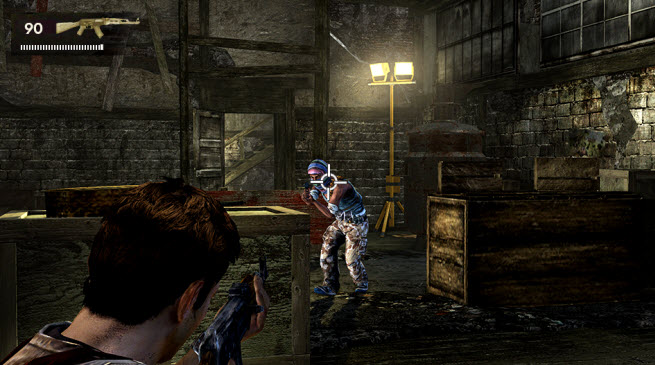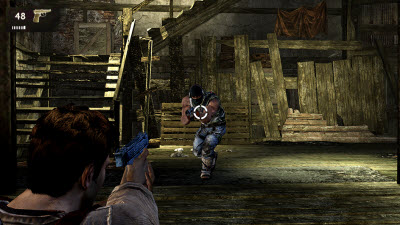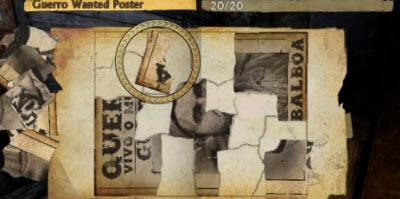Uncharted: Golden Abyss is the marquee game for Sony’s all-or-nothing bet in portable gaming, the PlayStation Vita.
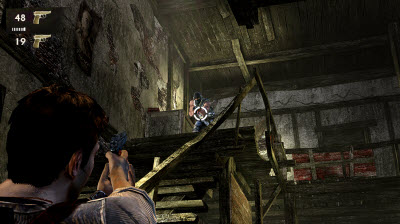 This handheld device is Sony’s last stand against competitors such as the Nintendo 3DS, not to mention the iPad, iPhone, and all of the other mobile devices out there that have become vehicles for inexpensive or free games. The Vita is a beautiful piece of hardware, and Sony hopes Golden Abyss is the showcase title to prove the system can keep up with high-definition consoles and can justify $50 price tags for game software. Sony wants the Vita to last for a decade.
This handheld device is Sony’s last stand against competitors such as the Nintendo 3DS, not to mention the iPad, iPhone, and all of the other mobile devices out there that have become vehicles for inexpensive or free games. The Vita is a beautiful piece of hardware, and Sony hopes Golden Abyss is the showcase title to prove the system can keep up with high-definition consoles and can justify $50 price tags for game software. Sony wants the Vita to last for a decade.
But stacking Golden Abyss up against big-brother predecessor Uncharted 3: Drake’s Deception really shows the inferiority of the portable platform.
Uncharted 3, which I and millions of others played in November, is fresh in my mind as one of the best games of 2011. On the other hand, the developers of Golden Abyss compromised the cinematic nature of the game — one of the series’ main selling points — just to show off some of the Vita’s unique control features (such as its touch-based back panel).
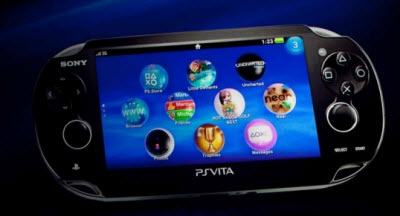 This is not to say that the Golden Abyss isn’t stunning and impressive at times for a handheld adventure. I can’t think of another that has this much spoken dialogue, voice acting, cutscenes, and lengthy levels with plenty of room for exploration. Sony’s Bend Studio should be commended because its game comes as close to a real console experience as any portable game has ever come, at least from my experience. It is far better than past PlayStation Portable narrative-based titles that were full of text-based dialogue and clunky graphics. Yet the marketing hype got too far ahead of reality on Golden Abyss, and its handful of flaws keep it from getting universal acclaim and being an all-around fun experience.
This is not to say that the Golden Abyss isn’t stunning and impressive at times for a handheld adventure. I can’t think of another that has this much spoken dialogue, voice acting, cutscenes, and lengthy levels with plenty of room for exploration. Sony’s Bend Studio should be commended because its game comes as close to a real console experience as any portable game has ever come, at least from my experience. It is far better than past PlayStation Portable narrative-based titles that were full of text-based dialogue and clunky graphics. Yet the marketing hype got too far ahead of reality on Golden Abyss, and its handful of flaws keep it from getting universal acclaim and being an all-around fun experience.
Protagonist Nathan Drake’s newest quest follows the familiar formula of the three Uncharteds before it, which have collectively sold at least 13 million units on Sony’s PlayStation 3. It has semi-accurate shooting, a movie-like action-adventure story with cutscenes that go on for minutes, lots of climbing (and nearly falling), and exotic environments. One of the problems is that it follows the formula too well, leading to a lack of surprises and freshness. It copies technical flaws, such as the inability to track a moving target and shoot it down quickly. It has fewer characters than a typical Uncharted and less character development. Multiplayer is non-existent (at least out of the box — downloadable updates may change this later), and the whole experience lasts around eight hours, somewhat shorter than a typical campaign in the series.
In this story, set before the events of the first Uncharted, the treasure-hunting daredevil Drake (voiced again by actor Nolan North) is on the trail of an ancient Spanish cult that was possibly behind the massacre of a conquistador expedition to Panama about 400 years ago. He shows up as the historical expert at an interesting archaeological site, and naturally, all hell breaks loose.
Drake is a polished character, making wisecracks and performing uncanny feats of parkour-like climbing as he moves through ancient ruins. Lead female Marisa Chase (voiced by Christine Lakin), on the other hand, makes a lousy first impression. Some of the dialogue early on between the two falls flat. And while she is sassy, she is nowhere near as likable a character as Elena from the Uncharted console games. Unlike her, Chase doesn’t fight at the outset, and Drake protects her for much of the adventure, as if she were entirely helpless in the face of bad guys. This dynamic forces the player to be aggressive in attacking enemies, as Chase always seems to be running headlong into danger so that Drake can bail her out.
At a couple of points, Chase complains that Drake is being sexist by not letting her do anything dangerous. But when the situation involves gun play or fighting, she’s perfectly willing to sit back and be rescued. Drake sticks his neck out over and over again for Chase, but it’s not because he really likes her. In fact, she’s kind of annoying. So it’s not really clear why he is so devoted to her.
Jason Dante, Drake’s fast-talking con-artist friend, on the other hand, is a comic figure who has a few witty lines that keep the cinematics from being completely forgettable. Dante fluctuates between good and bad, conveniently choosing either the role of a greedy compadre or a double-crossing villain, as it suits his purposes. Dante’s idea of being a good friend is to say in deadpan style, “No dying on me now, not while I still need you.” Meanwhile, the true bad guy is the rotund Roberto Guerro (voiced by JB Blanc), an ambitious general who runs drugs and is trying to seize the ancient treasures to finance a revolution in the country.
These characters fall short of the familiar cast of Uncharted, and only when one of them (to be nameless here for spoiler reasons) actually comes back into the picture does the game becoming more entertaining.
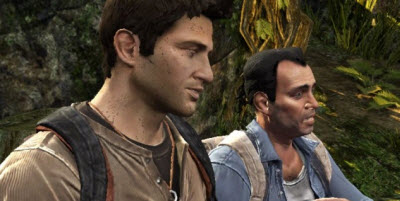 The early part of Golden Abyss
The early part of Golden Abyss
Uncharted: Golden Abyss opens with a prologue that is similar to the narrative styles of previous games. The scene takes you forward to a couple of weeks ahead of the beginning stage of the game. Nathan Drake sees his enemy in the distance and tells him he can go to hell. It’s not exactly the best opening dialogue, and it is far weaker than the dramatic intro of Uncharted 3.
The prologue teaches you how to control Drake, who appears onscreen in a third-person perspective. You can use the Vita’s two analog joysticks to move him around and change his facing. When Drake is climbing, you can “paint” the touchscreen with your finger to guide where you want him to go. This gesture requires you to take your finger off the action button (X), but it works reasonably well in these non-combat situations.
You can sneak up on enemies and quietly dispatch them with a single tap either on the right side of the screen or on a “fist” icon on top of the enemy. If you get into a melee brawl, you tap the fist icon repeatedly or swipe your finger across the screen, a gesture that the touchscreen often fails to recognize accurately. And that often results in Drake dying and a long load time to restore you to the last checkpoint. The touchscreen just isn’t a match for button pushing when it comes to accuracy and speed. (The boss melee battles are a little too tough just because they’re choreographed and timed — one misread with your finger and you’re dead.)
The Vita does shooting better than any other handheld I’ve played. But with Uncharted, it’s more often frustrating than satisfying. This is the crux that makes or breaks the whole experience of playing the game.
When you pull the left trigger of the Vita, a target reticle appears. If you disable auto-aiming (as any self-respecting gamer would do), then the reticle does not appear on top of the enemy you’re facing. To move it, you can push the analog joystick, which is pretty hard to control precisely, just as it is on any PlayStation controller. To assist your aim, you can lower the sensitivity of the joystick. I had to do this because my thumb moved the crosshairs all over the screen. I couldn’t hit anything at first.
The Vita offers some aiming tools that can help compensate for that and help neophyte players. If you tilt the Vita, the motion sensors will nudge the reticle toward your target. In a sniper rifle’s scope view, you can zoom in on an enemy in the distance by stroking your finger along the right side of the screen. With the tilt assist here, you can hit the targets reasonably well. I got used to this kind of shooting over time.
It’s not a bad system, but the nature of Uncharted’s enemies makes it more frustrating. The console version of the enemies are smart enough to know (call it a sixth sense) that you’re aiming at them as they’re hiding behind a rock. They will stick their heads out to shoot at you but not where your target reticle is sitting. So you have to move your aim quite a bit before you can nail enemies.
But there is almost no way to hit a moving enemy with any precision in Golden Abyss. That’s because your character turns too slowly when you are aiming — the same problem that Uncharted 3 has in its shooting system. It takes you a full 10 seconds to turn around 360 degrees while aiming down the sight. That’s just unacceptable when you’re trying to hit a moving target. It probably took me about 20 of the 34 levels to get used to this shooting system. The only good thing I can say about it is that I did get used to everything in time to deal with the increased difficulty of the latter levels, when you face tougher enemies with better weapons.
Tossing grenades is a unique experience on the Vita as well. You can tap on the screen to just throw one straight ahead in the general direction of the enemy. But this rarely seems to work because the automated system seems to have no depth perception. If you’re behind a barrier, the odds are good the grenade will bounce off of it and kill you instead.
But you can also tap the grenade icon in the lower-right section of the screen and drag the explosive to a spot on the screen. A white arc appears to show whether the path of throw will be obstructed or not. Then you simply take your finger off the screen to complete the maneuver. It works OK but not brilliantly.
The Vita’s rear touch pad also comes into play. You slide your fingertips to climb up or down ropes, which didn’t work that well (so I resorted to using another method). You can also rub the touch pad to simulating rowing in a canoe. I thought this was just a bad gimmick.
The touchscreen comes into play during puzzles, like when patching together torn pieces of paper to form complete images. You can rub the screen to wipe dirt off an object or get a charcoal imprint of an artifact. You can also take a picture of a scene to add to your collection as a sightseer in cool places. But this feature becomes frustrating because it takes a while to get the exact snapshot that matches a preset image in your photo-collectible achievement system. The photo capture is imprecise and a lame part of the gameplay.
In the end, all of these game and puzzle mechanics seem gratuitous. They exist because the developers seemed to desperately want to justify the many different hardware mechanisms that Sony’s crazed hardware engineers put on the Vita. They’re not really worth interrupting the narrative flow of the story or the gameplay.
